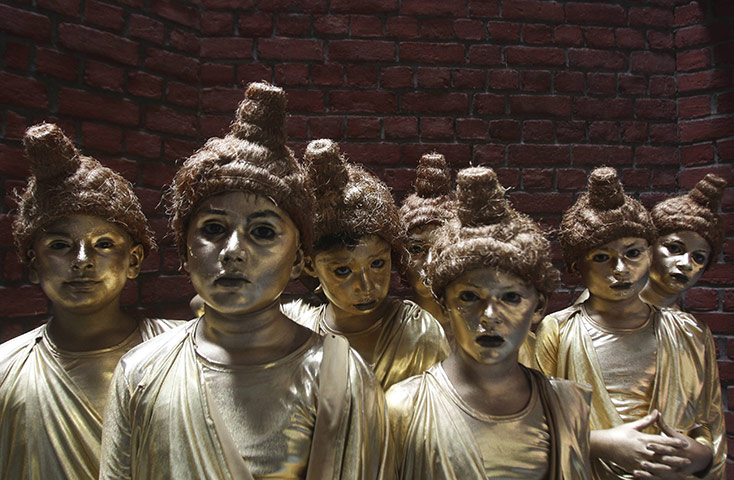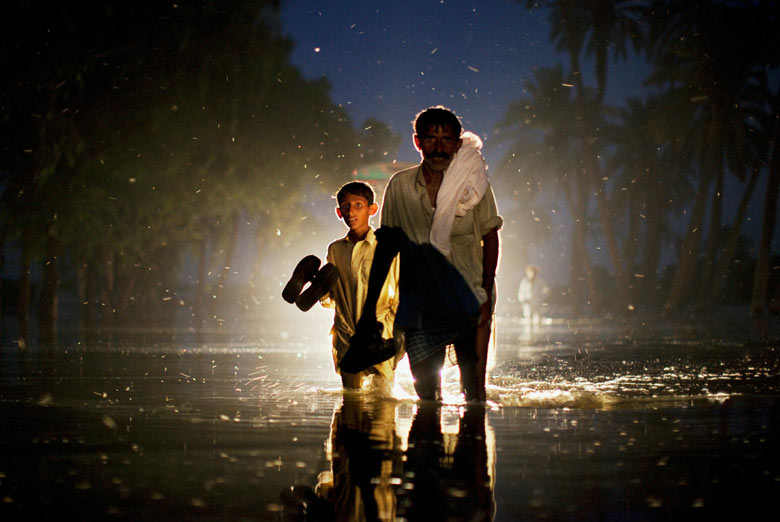September brings the religious festivals of Ramadan and the High Holy Days, while Christians have–what, Halloween? So for those readers who might be feeling a spirituality deficit, I thought we could turn to our Buddhist friends, or, at least, this photograph of children dressed up as Buddhas for a peace festival in Naida, India.

Perhaps I shouldn’t have labeled them, as they also could have appeared to be cheap Roman statues or extras for a low-budget sci fi film. Whatever they might be, there is no doubt that they are children. Where else could one find such openness before the social eye of the camera? Although the gold paint makes them appear masked, they are in fact unmasked, exposing the unique personality and momentary attitude of each individual. And as with Roman statuary, those individual faces in turn reveal how the human soul is traversed by suffering, self-consciousness, willful composure, and endurance that has been forged out of continuing vulnerability. Though but a photograph, we are brought to a moment of existential truth much like Rodin’s great statue of The Burghers of Calais, where distinct individuals share a common fate. The children seem to be looking at something both awesome and terrible, as if they have been brought before a sacrificial alter, perhaps one waiting for them. They are indeed thoroughly human.
But wait a minute–aren’t they Buddhists at a peace festival? What’s with the sacrificial alter? Perhaps my imagination is too grounded in an Abrahamic religion, but you can’t spin suffering out of Buddhism, and the photograph is a powerful testimony to something deeply human. It captures how we bind ourselves together through religious ritual and other forms of community in order to keep terror at bay, only to still suffer as we await destruction.
And that attempt to bind ourselves together and to God makes all the difference. Perhaps another reason the photograph struck me so powerfully is that it reminded me of the annual Christmas pageant. I don’t recall being in one, but I’ll never forget the first time I watched my children among the others dressed as little shepards, angels, and the like. There they were–halos askew, wings off-kilter, awkwardly yet intently trying to play their roles–and then it hit me: that’s how God sees us.
In other words, you don’t have to believe a thing about God or the divine spark in each of us to understand that human beings are over-matched by reality–pathetic creatures condemned to self-consciousness who survive only by amateurish acting in the theater of social life. And if you will accept for the moment that religion exposes humanity as it is, then you might go a step further and consider how any divine intervention is going to have to come through human hands.

I close with this image of refugees from the floods in Pakistan. Like the gilded children above, this image is obviously artifiical: a trick of back lighting suggests supernatural emanations. Again, no one label need apply. The man could seem to be something out of Night of the Living Dead, leading the boy to be sacrificed. Or they could appear to be bathed not merely by the flood waters but by some spiritual power that can withstand the monsoon and signify that they are worth saving. And as before, the child is watching, looking at something that awes and worries him.
These images are tinged with suffering, and they expose a few of the devices that human beings use to bind themselves to one another. Devices such as pageants and photojournalism. The question remains: will we see what is there to be seen when the sacred appears among people humbled by circumstances? People of low status such as children, or those who are knee-deep in flood waters. . . . I see humanity, over-matched yet enduring, watching and waiting, and perhaps wondering whether they will ever be treated as children of God.
Photographs by Parivartan Sharma/Reuters and Daniel Berehulak/Getty.
Discussion